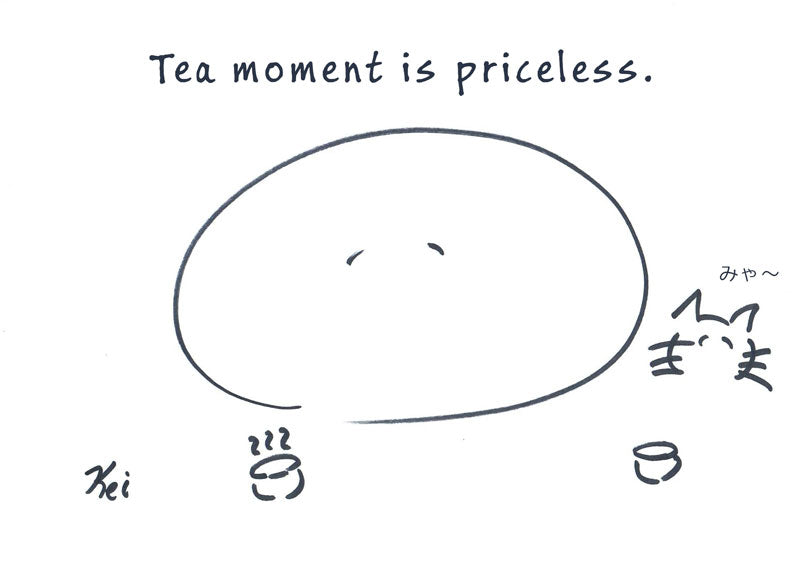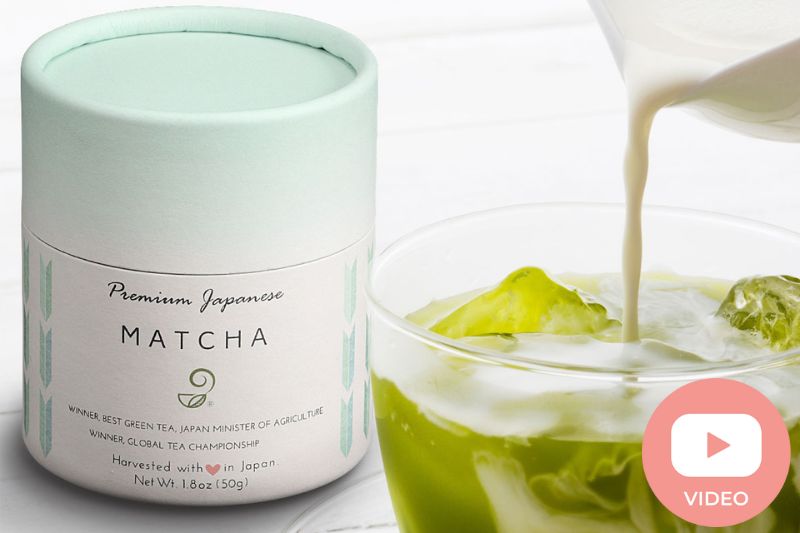Matcha green tea: maybe you’ve heard of it, or you've seen it as an exclusive menu item at your local café. All that’s clear about it is that matcha is a type of green tea that seems to saturate social media photos as an aesthetically pleasing, foamy green drink. Matcha flavored beverages are popular today, as well as overpriced. What is it about matcha that distinguishes it from other types of tea? What makes this exquisite green potion so costly?
What Makes Matcha Different?
Matcha green tea powder is derived from the same plant as other teas, Camellia sinensis. Each tea made from this plant is produced differently. In some cases, the leaves are simply steamed and dried. Other tea leaves undergo various stages of fermentation. Matcha is a true-leaf green tea, meaning the entirety of the leaves are used to produce a powder. To make basic matcha tea, the powder is mixed with hot water, creating a frothy, vibrant green liquid.
Japan - the Best Environment for Producing Matcha
Matcha literally means "ground tea," so one could argue the first people to grind tea leaves were the Chinese. However, the production of fine, bright green matcha powder was devised by the Japanese. (See my other article for more detail about this: Is Matcha Originally invented in China or Japan) They began the process of shading tea leaves, then steaming and drying them before pulverizing them. Without these steps, the taste, color, and nutrients of matcha powder would not be the same.
Although farmers discovered the benefits of shading by accident, it revolutionized the role of matcha in Japanese culture. Originally, green tea's main purpose was medicinal, but with the aromatic flavor born out of these new production methods, people began to drink it for taste, pleasure, and ceremonies.
Zen Buddhists ritualized the process of creating matcha through the Japanese Tea Ceremony. Tea ceremonies are precise, choreographed displays of graceful preparation of tea, in which the host dresses in traditional garb and stirs tea powder into hot water with a bamboo whisk.

Matcha Creation is a Complex Process
Today, Japan is the main production site for high-quality matcha powder. The fertile soil, mild climate, and slight elevation of the locations all contribute to quality matcha production. Already, it is clear why costs might be high if the overall available landmass for growing and preparing matcha is limited. In fact, for everyday matcha powder, the cost per gram is about $0.25–$0.50 in U.S. dollars. Ceremonial matcha, which is of the highest grade, costs $0.75–$1.00 per gram.
There are several reasons for that. During the farming process, tea leaves are harvested throughout the year, but the best time is in May. Leaves are picked by hand. For matcha, there is a specific way of optimizing leaf color, flavor, and nutrients that isn’t involved with other teas. Several weeks before the time of harvest, the plants are starved of photosynthesis by being shaded from the sun. By completing the growing process in darkness, the plants are forced to produce an abundance of chlorophyll, which lends itself to the vibrant green color, as well as amino acids. This makes the flavor more sweet and full-bodied, preventing bitterness. Furthermore, all nutrients, like antioxidants and catechins, are preserved.

Surprising Fact - Grinding Tea Leaves Takes a Long Time
The next phase of production also contributes to the high expenses. The picked leaves are dried and must be sorted by age. The younger the leaf, the higher the grade of the plant. The stems and veins of the leaves are removed by hand, which takes so much time and manpower. Once the tencha, the de-veined, de-stemmed leaves, have cooled, then comes the grinding. The highest quality matcha powder is milled by hand using granite stone wheels. The leaves are ground into the finest powder. In fact, procuring 30 grams of matcha powder takes more than an hour. That concludes the process before the powder is packaged and stored.
The More Nutritious, the Greater the Cost
Matcha green tea is different from other teas, not only in production but also in nutritional content. As you will later come to know, the distinct process of matcha cultivation is done carefully to maximize taste and health benefits.
Matcha is said to have about 137 more catechins than regular green tea. During the shade-blocking period right before harvest, the tea plants grow slowly and more delicately, resulting in soft buds with a high concentration of amino acids and glutamates. Because the entire leaf is ground into powder, all antioxidants are preserved and accessed. Matcha green tea contains high amounts of epigallocatechin (EGCG), about three times as much as other types of tea. EGCG is renowned for its prevention of cancer and its help in improving cardiac and metabolic health. The antioxidants, which are catechins, fight inflammation, especially in chronic conditions like rheumatoid arthritis.
Matcha also contains a higher quantity of caffeine than normal green tea. This, combined with L-theanine, a compound that promotes relaxation, improves brain function. Regular consumption of matcha tea has shown improvement in cognitive abilities like attention, memory, and reduced stress.
The richness of nutrients and numerous benefits contribute to the higher cost of matcha compared with other teas.

What About Chinese-Made Matcha?
Please note that I love Chinese tea, but the fact is that many of the matcha grown in China are not regulated, and there are so many sad facts about one not following good practices. This section describes tea production, but note that there are many tea productions in China that are of better quality.
All of the steps involved in matcha production are extremely intensive, time-sensitive, careful, and take so much labor and resources. Once it hits the market, the high price is justified. However, this is if you want a high grade, umami-flavored matcha. What if you don’t mind a lower quality in exchange for a more affordable price?
Many matcha “knock-offs” exist that run for a lower cost. China, the powerhouse of discount goods produces cheaper matcha that costs about $7 per ounce, as opposed to $26-$32 per ounce of Japanese matcha. The labor involved in Chinese-produced matcha is not as intensive. Chinese farming practices are more like a short-cut, wherein plants are not shade-grown, and the tea leaves are fried for quicker processing. This makes sense since the goal of such techniques is for increased quantity and accessibility, however, quality is vastly undercut.
Chinese production methods give matcha powder a grainy texture, as opposed to fine and dusty. This reduces the frothiness and nutritional value. It's not organic, nor is it closely regulated resulting in poor working conditions and the incorporation of artificial coloring and additives.
Environmentally, the soil in Chinese land is not optimal for high-quality tea leaf farming. Combined with the high likelihood of toxicity due to pesticides (some of which have been banned), the quality of matcha matches the affordable cost. Interestingly, most of the world purchase matcha that's been made in China.
Matcha green tea powder is an exceptional tea, the best of which is made in Japan. The price of the matcha can be quite high. Once you examine the underlying labor costs, time of processing, and meticulous care involved to create a matcha powder with many beneficial qualities, the cost makes sense.
This article was originally posted in 2019 and updated in 2023.
Buy Matcha Green Tea Online

Get Free Bonus Books

Sign up for free to the Green Tea Club to get advice and exclusive articles about how to choose Japanese Tea, and tips, tricks, and recipes for enjoying Japanese tea.
About the author
Kei Nishida
Author, CEO Dream of Japan
Certification: PMP, BS in Computer Science
Education: Western Washington University
Kei Nishida is a passionate Japanese green tea connoisseur, writer, and the founder and CEO of Japanese Green Tea Co., a Dream of Japan Company.
Driven by a deep desire to share the rich flavors of his homeland, he established the only company that sources premium tea grown in nutrient-rich sugarcane soil—earning multiple Global Tea Champion awards.
Expanding his mission of introducing Japan’s finest to the world, Kei pioneered the launch of the first-ever Sumiyaki charcoal-roasted coffee through Japanese Coffee Co. He also brought the artistry of traditional Japanese craftsmanship to the global market by making katana-style handmade knives—crafted by a renowned katana maker—available outside Japan for the first time through Japanese Knife Co.
Kei’s journey continues as he uncovers and shares Japan’s hidden treasures with the world.
Learn more about Kei








